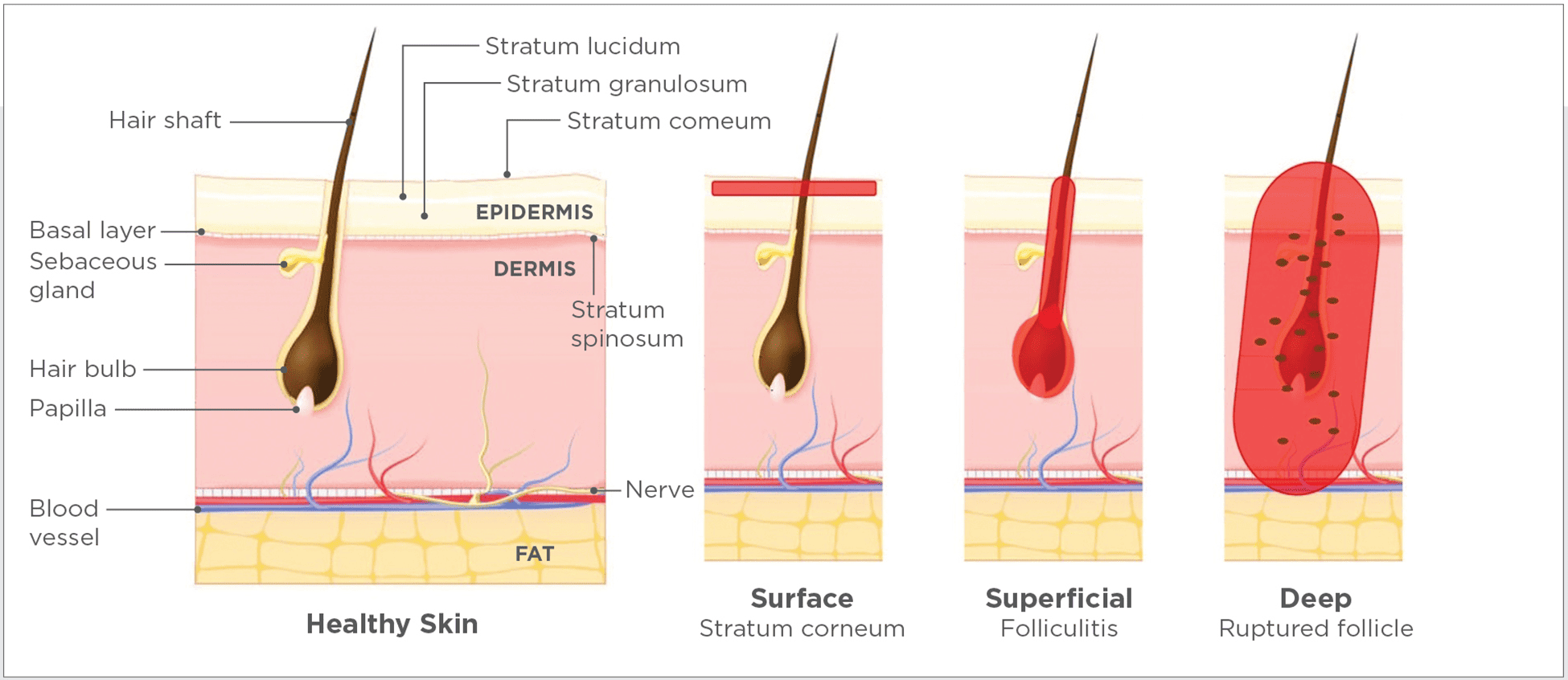Dog skin infection that affects the top layers of the skin is superficial bacterial pyoderma
Dogs are our cherished animal friends who fill our lives with happiness, fun, and affection. But dogs, like humans, can have various health problems, such as skin issues. One of the frequent skin troubles that dogs face is superficial bacterial pyoderma.
In this article, Japan Animal Hospital tells you what pyoderma means, how to identify and cure it, and above all, how to avoid it to maintain your dog’s health and well-being.
What is superficial bacterial pyoderma?
Pyoderma is a skin infection that mainly affects the top layers of a dog’s skin. This problem is caused by bacterial invaders, usually staphylococcus intermedius, which enter your dog’s skin through small wounds, scrapes, or irritated hair follicles.
Superficial bacterial pyoderma in dogs is usually harmless, but it is almost always a sign of an underlying disease. If the underlying disease is not found and the infection is not treated, it can turn into deep pyoderma, which is much more difficult to treat.

Source: https://todaysveterinarynurse.com/dermatology/pyoderma-in-the-dog/
Symptoms of pyoderma skin infection
Identifying pyoderma early is crucial for effective treatment. Common symptoms of pyoderma in dogs include:
- Redness and Inflammation: The affected area may appear red, swollen, and irritated.
- Pustules and Pimples: Small, pus-filled pustules or pimples may develop, which can burst and ooze.
- Hair Loss: Dogs with pyoderma may scratch so much that they rip out hair in the infected areas, leading to bald patches.
- Itching and Discomfort: Affected dogs often itch, scratch, or lick the infected areas due to discomfort.
- Unpleasant Odour: A foul odour can emanate from the infected skin.
This is what pyoderma looks like

Source: https://todaysveterinarynurse.com/dermatology/pyoderma-in-the-dog/
So, how does an animal develop pyoderma?
Cause of pyoderma
I can help you with paraphrasing your text. Here is one possible way to restate your text using different words:
Pyoderma is a skin infection that starts when the normal bacteria on the skin surface get into the deeper layers, usually because of small wounds or cracks in the skin barrier from SCRATCHING. So, any condition that makes your pet scratch can cause pyoderma. Also, animals with a weak immune system are more likely to get this condition, for example young puppies that have just stopped nursing and old animals.
Skin issues like parasite infection, atopic dermatitis, flea allergies, or food allergies and certain physical features, like the skin folds in Shar Peis, Bullmastiffs, and English Bulldogs will also make your pet more likely to get pyoderma. Poor grooming or environmental factors can also make your pet scratch and lead to pyoderma.
Bacterial pyoderma is either surface, superficial, or deep. Surface infections only affect the very top layer of the skin (stratum corneum), superficial infections only affect the epidermis and hair follicles, while deep infections affect the dermis, deep dermis, and can cause furunculosis (deep boils filled with pus and draining channels). Finding pyoderma is easy, but finding the many underlying conditions that can possibly cause pyoderma is much harder.
Remember that superficial bacterial pyoderma is not an allergy, but it can be a secondary sign of allergies.
Transmission of pyoderma
Pyoderma cannot be passed directly from one person or pet to another, but the bacteria causing it can potentially spread among people or animals living together in the same home.
So, what does the treatment of pyoderma look like?
Treatment of dog skin infection
Treating pyoderma involves both medical intervention and supportive care. Here’s how to manage this condition:
- Visit your veterinarian: If you suspect your dog has pyoderma, consult your trusted veterinarian promptly. Your vet will perform a physical examination, possibly take skin samples, and may recommend a culture to identify the specific bacteria causing the infection.
- Antibiotics: Antibiotics are the primary treatment for pyoderma. Your vet will prescribe the appropriate antibiotic based on the bacteria causing the infection. It’s crucial to complete the entire course of antibiotics, even if your dog’s symptoms improve before the medication is finished.
- Topical treatments: In addition to oral antibiotics, your vet may suggest topical treatments like medicated shampoos, sprays, or ointments to help manage the infection and reduce itching.
- Cleanliness and hygiene: Keep the infected area clean and dry. Avoid bathing your dog too frequently, as this can strip natural oils from their skin, potentially worsening the condition. Conversely, if your dog has skin folds, these may require more frequent cleaning & drying.
- Prevent scratching: Prevent your dog from scratching, e.g. by using a cone.
A regular vet check can help to keep your beloved furry friend healthy.
Book your dog’s consultation
- Phone: 010 303 088
- Telegram: 010 303 088
- Facebook : (1) Facebook
- Email: [email protected]
- Book an appointment with us today : Contact Us | Japan Animal Hospital Today
Visit us in No.M43, Preah Trasak Paem St. (63), Phnom Penh, Cambodia




